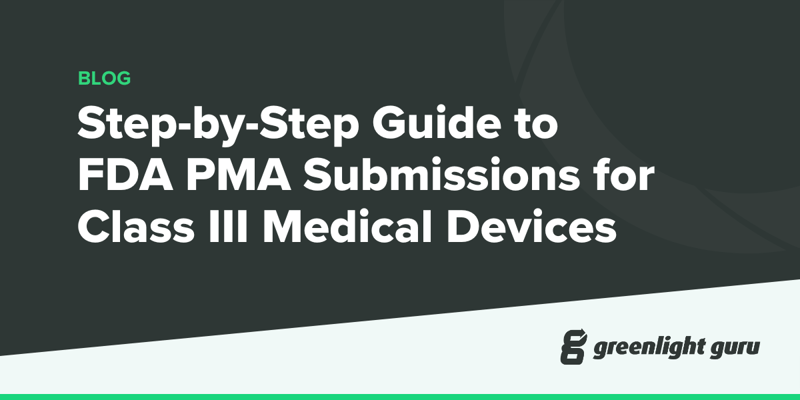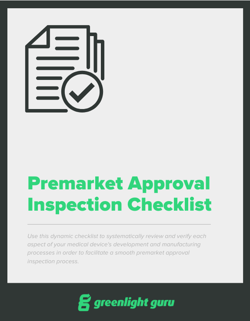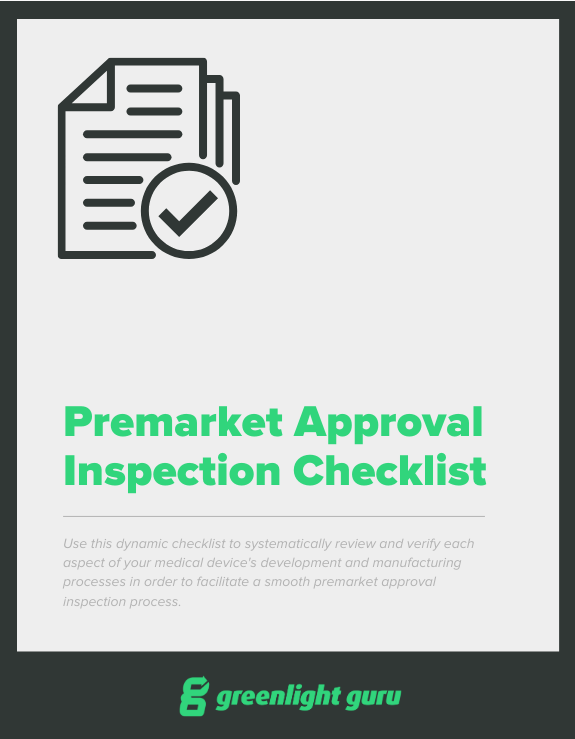Step-by-Step Guide to FDA PMA Submissions for Class III Medical Devices

The premarket approval (PMA) process is the method FDA uses to evaluate the safety and effectiveness of Class III medical devices before they can be placed on the US market.
FDA defines Class III devices as “those that support or sustain human life, are of substantial importance in preventing impairment of human health, or which present a potential, unreasonable risk of illness or injury.”
In essence, these devices hold the highest risk to patient health and therefore require the most stringent application and review process before they can be placed on the market.
In this article, we’re going to walk through the FDA PMA process to help you understand what you can expect on the journey to getting a Class III medical device to market.
BONUS RESOURCE: Click here to download a free, customizable Premarket Approval Inspection Checklist.
What is FDA’s premarket approval (PMA)?
FDA has three types of regulatory controls that they apply to medical devices based on their risk classification:
-
Class I devices (low to moderate risk) are subject to general controls
-
Class II devices (moderate to high risk) are subject to both general controls and Special Controls
-
Class III devices (high risk) are subject to general controls and Premarket Approval
As you can see, all devices are subject to general controls, though Class III devices are the only class subject to PMA, as the FDA deems that general and special controls alone are not enough to assure their safety and effectiveness. You can find the full requirements for the premarket approval process in 21 CFR Part 814.
What are the key components of the FDA PMA application?
Class III medical device manufacturers will be required to submit a PMA application and must receive FDA approval of their application before marketing their device in the US.
The PMA application will start with general information, including the name and address of the applicant, a table of contents, and a summary of all the information and data in the application (this should be about 10-15 pages). Following that, the PMA application must include:
-
A description of the device’s indications for use, including a description of the disease or condition the device will diagnose, treat, prevent, cure, or mitigate and a description of the patient population for which the device is intended
-
A thorough description of the device and its functional components or ingredients
-
Reference to any performance standards or voluntary standards followed
-
An environmental assessment in accordance with 21 CFR 25.20(n)
-
The methods, facilities, and controls used for manufacturing, processing, packaging, storing, and (if appropriate) installation of the device
-
A bibliography of all published reports
-
A sample of the device, if practical
-
Copies of all proposed labeling
-
Copies of the financial certification or disclosures of the clinical investigators
-
Information concerning uses in pediatric patients
There are two additional sections, typically known as the technical sections, that are especially important to consider. These are the sections on pre-clinical and clinical studies:
-
Results of nonclinical laboratory studies, which may include microbiological, toxicological, immunological, biocompatibility, stress, wear, shelf life, and other laboratory or animal tests, as appropriate.
-
Results of clinical investigations involving human subjects, including information such as study protocols, safety and effectiveness data, adverse reactions and complications, device failures and replacements, patient information, patient complaints, tabulations of data from all individual subjects, results of statistical analyses, and any other information from the clinical investigations. Any investigation conducted under an Investigational Device Exemption (IDE) must be identified as such.
The technical sections will make up a large portion of your PMA application, as these include the valid scientific evidence that will support your assertion that the device is safe and effective. You must also include the results of all investigations, whether adverse or supportive of your application.
I cannot stress the importance of your clinical data (and non-clinical testing data) enough. As we’ll see in the next section, clinical and non-clinical investigations that are not carried out in accordance with the appropriate regulations are grounds for a denial of approval.
You can double-check the completeness of your PMA application by referring to 21 CFR Part 814.20 and/or using the FDA’s PMA Review Checklist.
The FDA PMA process: an overview
Once your PMA application has been submitted to FDA, it will undergo a fairly standardized process. Before we get into the different routes your application can take, however, I want to take a moment to stress the importance of early and frequent communication with FDA about your PMA application.
Early communication with FDA and Q-sub program
FDA explicitly states that they encourage applicants to contact them before submitting their PMA application in order to get a better understanding of FDA regulations, requirements, guidance documents, and processes. Not only that, it will give FDA a chance to familiarize themselves with the device being proposed and any new technology it uses.
Basically, communicating early and often will facilitate the process for both sides and hopefully minimize any delays in what is already a pretty long process. There are a number of opportunities to get in touch with FDA both before and during the PMA process, and these are collectively known as the Q-Submission Program:
-
Pre-submissions
-
Informational meetings
-
Study risk determinations
-
Formal early collaboration meetings
-
Submission issue meetings
-
Day-100 meetings for PMA applicants
PMA application review
Once a manufacturer has submitted their PMA application, it goes through a four-step review process:
-
Administrative and limited scientific review (to determine completeness for filing)
-
In-depth scientific, regulatory, and quality system review
-
Review and recommendation by the appropriate advisory committee (panel review)
-
Final deliberations, documentation, and notification of FDA’s decision
One thing to keep in mind is that in step one, FDA is simply determining whether the application is complete and ready for filing. You’ll be notified within 45 days whether your application has been filed or not. If it is not fileable, FDA will tell you why and provide you with steps you can take to make your application fileable.
In-depth and panel review
If your PMA application is filed, then the substantive review of the application begins. During this time, you’ll definitely want to request your day-100 meeting with FDA to discuss the review of the application, as there may likely be major or minor deficiencies that you’ll need to correct.
FDA may also refer your application to an outside panel of experts. This is standard if your device is first-of-its-kind. If your PMA application is referred to a panel, they will hold a public meeting to review the PMA and then submit a final report to FDA with their recommendations.
The fourth step, notification of FDA’s decision, can go a number of different ways.
Possible FDA actions on a PMA application
Within 180 days of filing your PMA application, FDA will issue one of the following:
-
An approval order. This is an actual approval of the PMA application, conditional on the final draft labeling the applicant must submit to FDA before marketing the device.
-
An approvable letter. This means the application substantially meets the requirements and FDA can approve it if the applicant provides more information or agrees to specific conditions, such as a post-approval study. The applicant can either amend the PMA as requested, consider the approvable letter to be a denial and request an administrative review, or withdraw the PMA.
-
A not approvable letter. This means FDA believes that the application may not be approved or is unable to reach an approvable decision due to a significant lack of information in the application. The not approvable letter will describe what’s missing and the grounds for denial, as well as identifying what would make the application approvable. In response, the applicant can amend the PMA as requested, consider it a denial and request a review, or withdraw it.
-
An order denying approval. This means FDA has determined that the applicant failed to follow requirements for the PMA or that any of the specific grounds for denying approval apply to the application.
Remember earlier when we were talking about the importance of your non-clinical and clinical data? This is where that comes into play, as FDA explicitly states that the reasons for denial of approval of a PMA can include:
-
An essential nonclinical laboratory study described in the PMA was not conducted in compliance with the good laboratory practice (GLP) regulations in 21 CFR 58 and no reason for the noncompliance is provided, or, if it is, the differences between the practices used in conducting the study and the good laboratory practice regulations do not support the validity of the study.
-
Any clinical investigation involving human subjects described in the PMA that is subject to the Institutional Review Board regulations in 21 CFR 56 or to the Informed Consent regulations in 21 CFR 50 and was not conducted in compliance with these regulations such that the rights or safety of human subjects were not adequately protected.
Finally, keep in mind that FDA also has the power to issue an order withdrawing approval of a PMA if it comes to light that these issues with non-clinical and clinical investigations exist.
That’s why it’s so important to have a MedTech-specific electronic data capture (EDC) system on your side. With Greenlight Guru Clinical, you’ll have a single, compliant platform for collecting and managing all your clinical data, helping ensure that this essential part of your PMA application is airtight.
PMA post-approval requirements
As long and windy a road as the PMA application can be, approval is not the end of FDA’s PMA requirements. There are a handful of mechanisms FDA uses to ensure that high-risk devices continue to be safe and effective while they’re on the market.
Post-approval studies and reports
One common requirement for the approval of a PMA application is that the manufacturer conduct study(s) after approval to ensure the device continues to be safe and effective, i.e., post-approval studies. For example, these studies may be ordered to investigate long-term performance data that wasn’t available at the time of approval.
Manufacturers who are required to conduct post-approval studies as part of their PMA approval will also need to submit post-approval study reports at certain intervals, which will be stipulated in the approval order. The reports will need to include a study overview, a summary of the study’s progress, a summary of safety and effectiveness data, and an interpretation of the study results at that time.
PMA supplements
After your device has been approved, any changes to the device that affect its safety and effectiveness must be submitted as a PMA supplement. It’s extremely important to note that the PMA supplement must be submitted prior to implementing the change.
A change requiring a PMA supplement could include:
-
A new indication for use
-
A change in design
-
A change in packaging or labeling
-
A change in manufacturing sites
There are several different types of PMA supplements, and each is used depending on the type of change being made. They are:
-
Panel-track supplement
-
PMA supplement (180 days)
-
Real-time supplement
-
Special PMA supplement
Each has specific criteria for when to use them, which you can read more about on the FDA’s PMA supplements and amendments page or by watching this CDRH Learn video.
Note that you can make changes to your device after approval without a PMA supplement as long as:
-
The change doesn’t affect safety or effectiveness
-
The change is reported to FDA in a post-approval periodic annual report
30-day notices
As if the different types of PMA supplements were not enough, there’s one more type of submission that you’ll make to FDA if there is a change in manufacturing procedures or methods of manufacturing that affect safety or effectiveness: the 30-day notice.
In this case, the manufacturer may distribute the device thirty days after FDA has received notice of the change, unless FDA determines that the information in the notice is not sufficient. In that case they will notify the manufacturer that their notice has been converted into a 135-day supplement and provide information on what the manufacturer needs to do next.
This is a lot to keep track of, and I highly recommend you read FDA’s 30-day notice guidance in addition to the PMA supplements guidance and video.
Post-approval annual reports
As part of the continuing approval of a PMA, manufacturers will also be required to submit annual post-approval reports starting one year from the date of approval. The reports will identify any changes (PMA supplements), as well as reports in scientific literature concerning the device and any unpublished data from clinical and non-clinical studies related to the device. This is also where you will report changes that did not require a PMA supplement.
BONUS RESOURCE: Click here to download a free, customizable Premarket Approval Inspection Checklist.
Stay compliant and up-to-date with all the latest ISO and FDA best practices with Greenlight Guru Quality
The truth is that the requirements for establishing and maintaining a compliant quality management system aren’t changing all that much. But even small changes can have a big effect in an industry as important as MedTech. That’s why at Greenlight Guru, we think it’s wise to use a QMS solution that’s built specifically for MedTech companies.
With Greenlight Guru Quality, you can ensure compliance from the very start, with purpose-built QMS software that comes aligned with 21 CFR Part 820, ISO 13485:2016, and ISO 14971:2019. And you can rest easy knowing that we’re also keeping up with the latest regulatory changes and best practices in the MedTech industry, so you’ll never be caught off guard by a change.
Ready to see how Greenlight Guru Quality can help you ensure compliance and make your next audit a breeze? Get your free, personalized demo today →
Etienne Nichols is the Head of Industry Insights & Education at Greenlight Guru. As a Mechanical Engineer and Medical Device Guru, he specializes in simplifying complex ideas, teaching system integration, and connecting industry leaders. While hosting the Global Medical Device Podcast, Etienne has led over 200...
Related Posts
QMSR Explained: What FDA QSR & ISO 13485 Harmonization Means for Medical Device Companies
QMSR: The Future of FDA's Quality Management System Regulation for Medical Devices
FDA QSR Transition to ISO 13485: Is Global Regulatory Harmonization on the Horizon?
Get your free download
Premarket Approval Inspection Checklist











